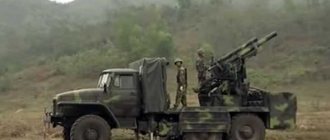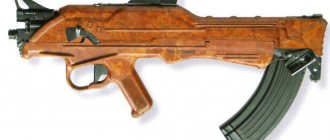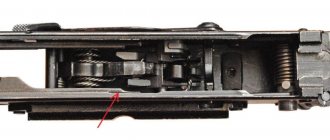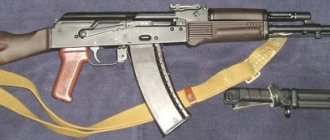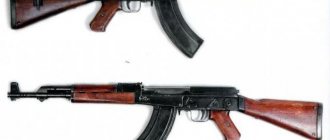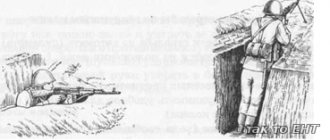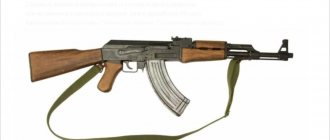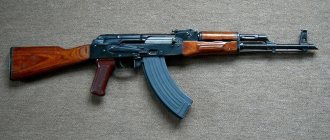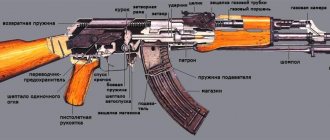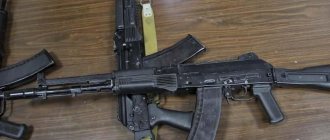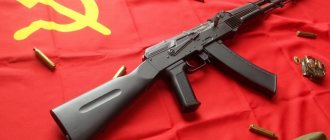Hello comrades. In the Soviet Union, over all the years of its existence, a huge number of interesting types of firearms were created. And it just so happened that the Soviet gunsmith German Aleksandrovich Korobov created many interesting samples of small arms. However, despite the outstanding characteristics of many prototypes, all of the weapons created by Korobov were never adopted for service due to rather specific design solutions. In this article I will tell you about the types of weapons that were created by German Aleksandrovich Korobov. So, let's begin.
TKB-408.
TKB-408 assault rifle.
TKB-408 is a Soviet experimental machine gun made using a bullpup layout.
TKB stands for "Tula Design Bureau". German Aleksandrovich Korobov created this weapon in 1946 to participate in a competition for a new machine gun for the Soviet Army. However, the TKB-408 did not pass the tests: the accuracy of fire was unsatisfactory and the survivability of parts was low. In addition, there were often delays when firing from this machine gun. As a result, the TKB-408 dropped out of the competition after only 5,000 shots could be fired from it, and the Kalashnikov assault rifle (AK) won the competition.
By the way, there is a common misconception among gun enthusiasts that the TKB-408 is the first Soviet assault rifle created using a bullpup layout, but this is not so.
In fact, even during the Great Patriotic War, experimental samples of such weapons were created, for example, the Korovin assault rifle.
TKB-517.
TKB-517 assault rifle.
TKB-517 is a Soviet experimental assault rifle, made on the basis of a semi-blowback automatic.
It was developed by German Korobov for a competition for a new machine gun, which was supposed to replace the AK.
The machine gun itself was a development of the TKB-454 series, the first machine gun of which (TKB-454-43) was created back in 1947. The main rivals of the TKB-517 were the AKM and the Konstantinov 2B-A-40 assault rifle. In addition, Korobov created an experimental TKB-523 light machine gun on the basis of his TKB-517 assault rifle.
This machine gun differed from the machine gun in its longer barrel length, butt shape, magazine capacity, and presence of a bipod.
Light machine gun TKB-523.
The TKB-517 assault rifle had an improved lever retarder, a simplified receiver, a new open sight and a forend made of sheet steel with ventilation holes. The military was especially interested in the semi-blowback automatics used in the TKB-517, since it could solve the main problem of the AK - low accuracy when automatically firing from unstable positions (the automatics of the AK itself were created on the basis of the removal of powder gases).
During testing, the machine showed high accuracy of fire and high manufacturability. At first, the TKB-517 had a great chance of being put into service. But in the end, AKM won. The TKB-517 assault rifle and TKB-523 light machine gun were not adopted for service.
This gave rise to several conspiracy theories among gunsmiths:
- Despite the fact that the TKB-517 was much better than the Kalashnikov assault rifle, the military was more accustomed to an assault rifle with a gas exhaust system, proven over years of operation, so they preferred the AKM at the hardware level.
- Weapons made on the basis of semi-blowback automatic weapons were unconventional for the USSR and among the conservative military command they were undeservedly considered inferior compared to Kalashnikov assault rifles.
- The victory of AKM is simply a political and propaganda move.
But in fact, all these theories are not true. The main problem of the scheme that Korobov used was the early unlocking of the bolt, due to which the internal parts were contaminated with powder soot. In addition, in this scheme, due to dry parts, the energy of the moving parts was reduced, and the automation itself was sensitive to external temperature due to pressure surges. That is why the AKM was adopted for service.
However, when discussing the results of tests of competitive assault rifles of the 1950s, in addition to listing the disadvantages of automatics based on a semi-blowback, the following phrase was also heard:
“The merit of comrade. Korobova is big, he showed Comrade. Kalashnikov ways to solve many issues.”
So Korobov, with his TKB-517 assault rifle, provoked a new round of evolution of Soviet weapons.
Machine guns of German Aleksandrovich Korobov
I think it will not be a discovery for anyone that during the entire existence of the Soviet Union, a huge amount of the most diverse small arms were created. Some things have gained worldwide fame and are used now, while others remain behind the scenes. However, the fact that a particular model did not go into production does not mean that it was bad or unsuitable for use. Of course, many of the models were indeed inferior in some ways to those that entered service, but there were also those that were superior in their parameters to existing models, but were rejected due to the complexity of production or for some other reason. In this article, I propose to get acquainted with samples of machine guns by German Aleksandrovich Korobov, who participated in competitions for machine guns for the Soviet Army and, as we know, lost to AK, and in the end to AN. Perhaps it’s worth starting with the fact that for me personally, German Aleksandrovich Korobov is, so to speak, an example of a domestic gunsmith. Of course, according to the majority, this is Kalashnikov, but for some reason I am closer not to the one who constantly won all the competitions, but to the one who fought in each of them, never tired of improving his weapon, despite any failures or oblique views from colleagues. Agree that when your developments are rejected at every competition, and many of them reach the finals, but do not win due to the fact that production needs to be re-equipped for them, this greatly affects the desire to do something else. Nevertheless, from the first to the last competition held for new machine guns for the army, German Aleksandrovich Korobov participated, and the fact that his weapons constantly “flew by” only pushed the gunsmith to improve designs and search for new solutions. In other words, for me German Aleksandrovich Korobov is an example of what a person should be.
I want to say right away that this article will not mention how and who made their way “to the top”, there will only be bare facts about weapons, so I hope that I will not offend anyone with this article, although I already have a definite opinion about “competitions” has developed and it is not the most positive. In general, let's go.
TKB-408-2 Automatic “Bull”
In 1943, the GAU formed the first requirements for a competition for a new machine gun for the army, from that moment Korobov began working on his machine gun. In 1945, these requirements were adjusted, and the future winner Kalashnikov entered the arena. Unfortunately, Korobov’s assault rifle dropped out of the competition because it did not meet the conditions for combat accuracy and withstood only 5 thousand rounds of fire. But “the first damn thing is lumpy,” let’s try to figure out what kind of lump it was.
This machine gun is especially noteworthy, since it is made not in a classic layout, but in a bullpup layout, which, you see, is quite bold for the first competition for a machine gun for the Soviet Army. However, this is far from the first example of a weapon in a similar configuration; there were similar models before it, even in the Soviet Union, for example, the Korovin assault rifle. Actually, the whole calculation was based on the unusualness of the design; it was assumed that one single sample in such an arrangement would attract attention with its small dimensions, and indeed it did. But, unfortunately, I was attracted not by its size, but by a bunch of nuances that are inherent to weapons in such a configuration. Thus, it was noted that this machine gun has negative qualities in the form of an inconvenient change of weapon magazine, a close distance from the shooter’s face to the window for ejecting spent cartridges, which led to irritation of the mucous membranes with powder gases and completely excluded the possibility of firing from the left shoulder.
The automation of the Korobov assault rifle was built according to a scheme with the removal of powder gases from the barrel bore; the gas piston was placed above the barrel of the weapon. The barrel bore was locked when the bolt was skewed in a vertical plane; the return spring was also placed above the barrel of the weapon. An insignificant, but very interesting point was that the window for ejecting spent cartridges was covered with a lid. The shutter handle was on the left side. It was also interesting that in comparison with the first “golden” Kalashnikov assault rifles, the receiver of which was made by milling, the Korobov assault rifle was much cheaper to produce, since virtually all its parts were made by stamping. It was also noteworthy that the fuse and the fire mode translator were separated. So the fire mode switch was located on the left, and the safety switch was located in front of the trigger. The sights were, naturally, open, the rear sight was mounted on the receiver, and the front sight was mounted on the gas tube. This machine was fed from detachable box magazines with a capacity of 30 rounds; the magazines themselves were fixed to the pistol grip of the weapon. The length of the weapon was 790 millimeters, and the weight of the machine gun was 4.3 kilograms.
Of course, this sample cannot even claim to reach the finals of the competition due to its low survivability. However, we should not forget that such an event was held for the first time, and there was virtually no experience in creating such weapons, so it is worth making allowances for the fact that this is Korobov’s first example of an assault rifle. It will be more interesting later.
TKB-454
Despite the complete failure of the “Bull” at the 46-47 competition, German Aleksandrovich Korobov did not give up the idea of creating a new assault rifle that would be cheaper, simpler and better than the Kalashnikov assault rifle that was in service at that time. Already at the end of 1947, a new machine gun TKB-454-43 was created, which was the first machine gun in the world to implement a gas braking system for a blowback, and this was when using 7.62x39 cartridges. Korobov came to the conclusion that after the launch of the Kalashnikov assault rifle into production, it is too late to propose something to replace it, the exception may be a really very simple and at the same time reliable design, which will cost several times less than the production of an AK. All this was implemented in the TKB-454-43, in addition, the weapon’s automatic system made it possible to reduce the recoil when firing by almost half, which only had a positive effect on the accuracy and ease of control of the weapon during firing. This attracted the attention of the Ministry of Defense, which decided to unscheduled test this weapon. Despite the fact that it was possible to bring this system to the ideal, Korobov himself decided to abandon it, giving preference to lever braking of the shutter, and this is how the TKB-454-5 appeared, which turned out to be no less interesting than the previous model.
The automation of the new version of the machine gun was built on a semi-free bolt, with lever support; the barrel bore was locked through the retarder lever with the mass of the bolt stem. Korobov perfected this operating principle in models 6 and 7A. In 1951, a new model was introduced. However, it was never possible to fully test it. The reason for this was the barrel coupling, which again could not withstand long-term firing from a weapon. Only in 1952 was it possible to create a more or less working model. So its main positive aspects were an increase in the accuracy of fire, depending on the level of training of the shooter, by 1.3-1.9 times, a reduction in production costs by 2 times, and a weight reduction of half a kilogram in comparison with the Kalashnikov assault rifle then in service. In addition, there were also negative aspects that concerned the survivability of individual parts, which in principle is not surprising, given the loads they experienced. There was also a slight decrease in bullet speed, an uneven rate of fire, and an increase in the muzzle flame.
In order to more accurately compare the capabilities of the Korobov assault rifle and the Kalashnikov assault rifle, about 20 weapons were ordered; during the comparison, Korobov naturally lost, since his sample was less reliable, which was not covered even by its cheapness and ease of production. However, at the same time, it cannot be said that the gunsmith wasted time on development. Fortunately, gunsmithing is a field of activity where even mistakes can bring benefits, sometimes even greater than positive experience. Thanks to the work that Korobov carried out, the knowledge base of other gunsmiths was replenished, and they already took this experience into account. If we look at this issue from the practical side, then Korobov’s developments were useful to him in another model, the TKB-517 assault rifle, but more about that below.
TKB-517
It was in this weapon that the character of German Aleksandrovich Korobov manifested itself. Despite the fact that the development of an assault rifle based on a semi-blowback was considered inappropriate, the gunsmith did not stop and nevertheless finalized his assault rifle, just in time for the new competition. And these efforts almost paid off. This model of machine gun became the main competitor of the AKM; in addition, the Korobov light machine gun was also presented. Having corrected all the weak points of his weapon, Korobov demonstrated a reliable and cheaper to produce model, which at the same time had an accuracy almost twice as high as its competitor. In other words, the Korobov assault rifle “teared” the AKM like a hot water bottle, exactly until the weapon was sent for revision. They began to “lick” the Kalashnikov assault rifle with all the forces they found, but with the Korobov assault rifle everything was completely different, as a result, it did not even make it to the field tests, since there was no point in sending a weapon that simply had not been modified by anyone. As a result, later, when the question of modifying the TKB-517 was raised, there was a refusal with the wording that the Korobov assault rifle could not surpass in its parameters the Kalashnikov assault rifle that had already been mastered in production. In general, since the Inquisition said that the sun revolves around the earth, it is better to agree with this. Thus, we can consider that this formulation buried the domestic FAMAS, which was also 15 years ahead of its time.
The machine gun was 930 millimeters long, fed from detachable magazines with a capacity of 30 rounds. The weight of the weapon was 2.78 kilograms. There was also an option with a folding stock instead of a fixed one. In my opinion, the fact that this machine gun did not win the competition is precisely the most offensive loss of Korobov’s weapon, since here, in fact, they said in plain text that you don’t have to try, in all competitions the winner is Kalashnikov. Although from a financial point of view, perhaps they were right.
TKB-022
After the TKB-517 was rejected, anyone would have given up, but not German Aleksandrovich Korobov, who again returned to the idea of creating weapons in a bullpup layout. Naturally, there was anger at the refusal and he took it out in a rather unique way - he created a whole family of weapons with a rather futuristic look. Naturally, it’s just a waste of government money. Nobody would have allowed Korobov the money, and his conscience would hardly have been happy about all this. Therefore, in addition to its unusual appearance, the weapon also had no less unusual characteristics. In other words, German Aleksandrovich Korobov continued to create quite good samples of weapons, however, the wrapping of these samples was, well, very specific. Actually, there is no point in saying anything, just look at the photo of this “disgrace.”
We will not dwell on the detailed characteristics of this weapon, since these are 9 machine guns, it is only necessary to note that these samples were either close in their parameters to the AKM, or were superior to it, and this with less weight and dimensions. However, the samples turned out to be only experimental ones, since in addition to combat characteristics there are other evaluation criteria, for example durability, and since all models were made with the extensive use of polymers, there was no talk about durability, after all, the plastic of that time was somewhat different from modern ones used in weapons.
Again, it can be noted that German Aleksandrovich Korobov looked into the future with his ideas. Naturally, such plastic machine guns were not suitable for use throughout the army, but they would be more convenient for performing certain special tasks. In addition, the widespread use of plastic in weapons was still 20-25 years away.
TKB-072
Not everyone liked the transition to the new 5.45 ammunition, but be that as it may, the transition has taken place and we need to work with the new cartridge. This is what German Aleksandrovich Korobov did. It was he who was the first to familiarize himself with the requirements that were issued for new weapons chambered for 5.45x39 and came to the conclusion that he could not only meet these requirements, but even exceed them. The fact is that Korobov carried out quite interesting work to determine the dependence of the accuracy of fire on the rate of fire of the weapon and the position of the shooter. During this work, Korobov found out that the best performance, when the shooter is in an awkward position for firing, is obtained when firing at a rate of fire of 2000 rounds per minute. When shooting prone, the optimal rate was 500 rounds per minute. Thus, it turned out that the weapon must have two rates of fire in order to not only meet, but also exceed the requirements. At the same time, Korobov led the development of a balanced automation system. In other words, the gunsmith decided to combine all this that was at hand in one weapon. So the TKB-072 turned out to be a two-speed automatic with balanced automatics and breathtaking characteristics for that time. It seemed that this was the moment of triumph, when there is an ideal weapon and production will in any case have to be rebuilt for a new weapon and a new cartridge, but no, this time it was also a mistake.
The whole bummer was another “request” to remove one of the firing modes. This was motivated by the fact that it would be difficult for a soldier and there would be no time to switch weapons from one mode to another in combat conditions. Having given the gunsmith a choice of which hand to cut off, right or left, all attention was switched to the Kalashnikov assault rifle. Korobov’s assault rifle, although it stood out among all the competitors in that it was created with balanced automation, however, it lost its main advantage - the two-tempo firing mode. They left him the opportunity to shoot at a speed of 500 rounds per minute, apparently to play it safe in case of complaints about too rapid consumption of ammunition. Naturally, with the same rate of fire, the machine gun could not win this competition. Nevertheless, let’s briefly get acquainted with what kind of weapon it could be, and let’s estimate whether the victory once again went to the AK fairly, or whether the fact that it was the most famous Soviet gunsmith, the Kalashnikov assault rifle itself, still played a role a kind of brand and so on.
The automation of the Korobov TKB-072 assault rifle is built according to a shockless design, with balanced automation. This means that the moving mechanisms in the weapon have minimal impact on shooting accuracy. Initially, Korobov, in addition to two rates of fire, also wanted to add the ability to cut off 3 rounds, but just before the competition he changed his mind and deprived the weapon of such a function, which in my opinion is completely justified, since even a macaque can be taught to shoot in fixed bursts. An interesting feature of the TKB-072 assault rifle is the neck of the magazine receiver, it is clearly difficult not to hit it, although if the weapon is in the hands of domestic football players... On the right side there is a fire mode switch and a safety switch, but otherwise this assault rifle does not stand out in any way outwardly.
It can be assumed that German Aleksandrovich had a time machine lying around in his closet, since TKB-072 is more reminiscent of a weapon that was created to meet the requirements of a completely different future competition “Abakan”, but if the possibility of firing in fixed bursts had been left, then there would definitely be no doubts there wouldn't be.
TKB-0111
After the AK-74 was adopted, a number of shortcomings were identified, both in the weapon itself and in the ammunition it uses. In particular, quite a lot of questions arose about the accuracy of the battle when firing in bursts, since only the first bullets (bullets) hit the target, the rest flew away to chase the crows. Thus, a new weapon was required, ideally capable of hitting a bullet with a bullet, which would also have a positive effect when shooting at enemy personnel protected by personal protective equipment. Despite the fact that during the competition Korobov was asked to remove one of the shooting modes, when problems arose with the new weapon, they remembered the two-tempo machine gun and included its characteristics in the requirements for the new weapon. It would seem that Korobov’s finest hour had finally come, all that remained was to take the old machine gun, bring it to the commission and it was in the bag, because the requirements for the competition were copied from this particular weapon, but not everything is so simple. Firstly, other designers also do not stand still, and secondly, even that design could be improved and simplified, so German Aleksandrovich Korobov got to work again, getting ahead of himself and with a not very successful ending.
The new machine gun was called TKB-0111, it was already built according to the scheme with shock automatics, had two rates of fire, but this time no one asked to remove anything. The thing is that Korobov set a cutoff of three rounds for a higher rate of fire, that is, it was simply impossible to fire a long burst at a high rate. The rate of fire was also slightly changed due to the presence of a three-round cut-off. So, the low rate remained 500 rounds per minute, but the high rate was reduced to 1700 shots. The Korobov TKB-0111 assault rifle itself is a completely modern weapon, even by today’s standards. The length of the machine gun is 930 millimeters, while the weight is 3.69 kilograms. The butt, unfortunately, is not brought into the line of fire, but in this case this may even be a good thing, since the shooter can remain with most of his face in cover, in addition, the impact “Korobov” automatics behave almost like a balanced one, which also plays a role important role. Generally speaking, in this model German Aleksandrovich Korobov was able to fit all his experience that he had accumulated over almost half a century of weapon design, but this was not appreciated, which in principle is not surprising.
Throughout the competition, three finalists were clearly visible: a Nikonov assault rifle, a Stechkin assault rifle, and a Korobov assault rifle. At the same time, Korobov was clearly in the lead. But in the end they decided to leave only those samples that had a movable barrel, due to which the recoil from several shots was summed up. As a result, Korobov’s assault rifle made it to the finals with the “optional” mark, but, apparently, no one got to the weapon that had to be considered outside the competition. In general, if we focus specifically on the accuracy of shooting with fixed bursts, then the Nikonov and Stechkin assault rifles were really better in this regard than the Korobov assault rifle, which is not surprising, because that weapon was designed for such shooting with all the ensuing nuances in the design. However, the commission did not take into account the complexity of production and maintenance of these samples in comparison with the Korobov assault rifle. So once again Korobov did not win the competition, this time his last. By the way, please note that the Korobov assault rifle beat out the currently quite popular, but very crude at the time of the competition, AEKs, and as a result they received at least minimal distribution, but the TKB-0111 did not.
Of course, this is not all the weapons that were designed by German Aleksandrovich Korobov; not even all the machine guns of which he is the author are presented here. Korobov had weapon models that actually came into service and worked well, however, not among machine guns. Despite all his efforts, Korobov was never able to defeat AK. It is difficult to say whether it is good or bad, if people have not yet learned to predict the future, then it is even more useless to try to predict the possible future. Nevertheless, we can say with confidence that German Aleksandrovich Korobov repeatedly created promising weapons, which for some reason, I will not specify what, were passed over. It is not difficult to guess that this can be safely equated to treason, since, in fact, where there could have been a breakthrough 10-15 years in advance, everything remained in place. At the same time, money was spent on the possible “breakthrough” itself, but there was no return.
In fact, it is a pity that the works of German Aleksandrovich Korobov remained unclaimed, after all, the developments that other gunsmiths use are one thing, but the weapons used by an entire army are completely different. I would like to see that at least someone took one of the designer’s works, even his latest TKB-0111, and brought it to modern standards, because the idea itself is truly unique of its kind, and after a week of training, anyone will automatically switch the pace shooting depending on your position. A semi-blowback automatic was also not a bad idea. Moreover, recently the question of replacing the 5.45 cartridge with a larger caliber cartridge from 6 to 7 millimeters has become urgent, so it’s time to think about both the cartridge and the new/old weapon. In the end, everything has already been invented long before us, all that remains is to take it, adapt it to modern requirements and put it into production.
TKB-022.
TKB-022 assault rifle.
TKB-022 is a family of Soviet experimental assault rifles.
Some models of these assault rifles were created using a pistol design (a detachable magazine replaced the pistol grip), while others were created using a bullpup layout.
All these samples were developed by German Aleksandrovich in the period from 1961 to 1962. None of these assault rifles were put into service due to controversial design decisions
:
- A plastic body, which reduced the weight of the weapon, but was not particularly durable.
- The center of gravity is strongly shifted back due to the bullpup layout and the short length of the weapon.
- Excessive novelty, which frightened the conservative military leadership.
Now let’s look at examples of these machines:
- TKB-022 No. 1
,
TKB-022 No. 2
And
TKB-022 No.Z
- machine guns created in 1961 using a pistol design. The automation of these samples was based on the removal of powder gases from the barrel site, and locking was carried out by turning the bolt.Please note: Increase the validity period of a permit to store and carry firearms from 5 to 15 years.
During factory tests, 13,350 rounds were fired from TKB-022 No. 1 without delay, and 3,036 rounds were fired from TKB-022 No. 3.
The accuracy of fire of these machine guns was not inferior to the AKM. - TKB-022P No. 1
,
TKB-022P No. 2
and
TKB-022P No. Z
- these machines were created in 1962.
TKB-022P No. 1 is made according to the pistol design, and the remaining samples are made according to the bullpup layout. There are many plastic parts in the design of these samples. In terms of accuracy, these assault rifles were also not inferior to AKMs.
Automatic TKB-022P No. 1.
- TKB-022PM No. 1
and
TKB-022PM No. 2
- all these machines were made using a bullpup layout and they stand out from the rest of the machines in this series with their appearance.
When creating these samples, an emphasis was placed on increasing the accuracy of fire from unstable positions.
In this parameter, the TKB-022PM series assault rifles are three times superior to the AKM. The ejection of spent cartridges was carried out near the muzzle, which made these machine guns equally convenient for both right-handers and left-handers. The TKB-022PM series assault rifles differ from the previous ones in their original bolt design and the ability to install a muzzle attachment for throwing rifle grenades. The safety switch for firing modes is located on the left above the pistol grip.
Automatic TKB-022PM No. 1.
- TKB-022PM5 No. 1
- externally, this machine gun is the aforementioned TKB-022PM No. 2, but differs from it in that it was created for a 5.6x39 mm caliber cartridge. This weapon was superior to the AKM when fired from a prone position with the hand at a range of 100 meters.
Too early?
The 60s in the USSR can be called the golden age of Soviet bullpups. The authors of the revolutionary concepts were the already mentioned German Korobov and another Tula designer - Nikolai Afanasyev.
The TKB-022 series of assault rifles is considered one of the most interesting Korobov developments. It was a compact weapon in a plastic case. In terms of design and materials used, the system was an absolute breakthrough - the famous plastic Steyr AUG would appear in Austria about fifteen years later. In the TKB-022P models, the magazine with cartridges was inserted directly into the fire control handle, like the Israeli “UZI”. And the TKB-022PM models were distinguished by their ultra-small dimensions: with the same barrel length of 415 millimeters, the Korobov assault rifle was 11.5 centimeters shorter than the AKMS with a folded butt. This was achieved through the use of a wedge-shaped bolt, which moved in a vertical plane, while the magazine with cartridges was located at the very butt plate.
TKB-022P
Photo: zonwar.ru
Another innovative solution of the TKB-022 was the ejection of spent cartridges forward, which solved the problem of firing from the left shoulder. Subsequently, this technique will be used on the Belgian rifle of the 21st century - FN F2000.
In general, according to available estimates (official test results have not yet been published), Korobov assault rifles had characteristics close to the AKM, but were noticeably superior to the latter in terms of compactness.
Nikolay Afanasyev’s TKB-011 assault rifles used a number of Korobov’s design solutions: general layout, materials used, ejection of cartridges. At the same time, the weapon had an extremely unusual appearance: the front and rear parts of the receiver were located at an angle to each other. The reference books indicate that plastic is widely used in the design of Afanasyev's bullpups, although some sources report that the cases of museum samples are wooden.
TKB-022PM
Photo: vitalykuzmin.net
Bullpups of the 60s remained prototypes. “It’s hard to say what they didn’t like, because the archives have not yet been opened, this information is not publicly available,” explained small arms historian Maxim Popenker. One of the obvious problems is the excessively rearward balance of the TKB-022PM. Combining the neck of an automatic magazine with the TKB-022P fire control handle is also a dubious ergonomic solution. Finally, a common problem with bullpups is a short sighting line, which negatively affects shooting accuracy. It is no coincidence that the same Steyr AUG has an optical sight as the main one.
TKB-011 assault rifle, model 1963
Photo: vitalykuzmin.net
Let's add to this the conservatism of military officials: will a plastic machine gun be able to show the same survivability as a steel one when used in difficult conditions? Will the plastic lose its properties if the weapon is stored in warehouses for decades under temperature changes? In general, there were a lot of “buts”, despite the fact that the gain in combat characteristics was not too obvious.
TKB-059.
TKB-59 assault rifle.
TKB-059 (aka “device 3B”) is a Soviet experimental three-barreled bullpup assault rifle.
Korobov created this machine gun in 1962 as a replacement for the AKM. TKB-059 was chambered for 7.62×39 mm caliber.
During the development of the TKB-059, emphasis was placed on an ultra-fast burst, in which the machine gun did not have time to deviate from the recoil, which in theory should have ensured high accuracy of fire. The main features of this weapon are the presence of three barrels, which allowed for salvo fire and an extremely high rate of fire (from 1400 to 1800 rounds per minute).
To unify the assault rifle, some parts and components were borrowed from the Kalashnikov assault rifle.
"Little anti-aircraft gun."
During the test, thanks to the simultaneous firing of three barrels in a burst, the machine gun actually showed extremely high accuracy. However, due to the specificity of the design, the complexity of equipping the magazines and the lack of need to replace the AKM, the TKB-059 assault rifle was not adopted for service.
Korobov assault rifle TKB-454-7A
The TKB-454-5 assault rifle and its improved modifications TKB-454-6 and TKB-454-7A turned out to be extremely simple due to the lack of a gas system and rigid locking, easy and technologically advanced to manufacture. Conducted factory and field tests revealed that Korobov’s weapon is superior to the Kalashnikov assault rifle in terms of accuracy of fire in bursts by poorly trained shooters, and in terms of the reliability of the automation, it meets the specified requirements.
Another Korobov design was the 7.62-mm TKB-454-7A assault rifle, which successfully passed factory and field tests in 1952 and was recommended for military testing at the Vystrel courses. During testing, the assault rifle received positive ratings, outperforming the lightweight AK assault rifle by 1.3-1.9 times when shooting with continuous fire while lying down from a rest position by poorly trained shooters.
TKB-072.
TKB-072 assault rifle.
TKB-072 is a Soviet experimental assault rifle, created for the intermediate cartridge of 5.45x39 mm caliber.
German Korobov created this machine gun in the second half of the 1960s.
In 1965, the USSR Ministry of Defense decided to create an assault rifle chambered for 5.45×39 mm caliber. Soon, Soviet gunsmiths were given the task of creating new weapons.
Korobov began conducting ballistic tests. Based on the results of these tests, he concluded: in order to achieve the required accuracy, it is necessary to create a two-tempo machine.
And so, in 1967, Korobov created the world's first two-rate machine gun with a high rate of fire of 2000 rounds/min and a regular rate of 500 rounds/min, as well as the first burst length cutoff mechanism.
This weapon was designated TKB-072.
In 1968, Korobov was given an author's certificate for an automatic machine with a balanced automation circuit. TKB-072 participated in the competition for a new machine gun for the Soviet Army. But in the end, the AK-74 won the competition; this machine gun won despite the obvious shortcomings that were passed on to it from the AK and AKM. And the TKB-072 assault rifle was removed from the competition due to the fact that the system for switching the automatic fire mode from high to low turned out to be too complicated.
Korobov assault rifle TKB-454-5
The following year, 1948, a new Korobov assault rifle appeared - TKB-454-5. Its automation worked on the recoil principle of a semi-free shutter with lever support. Locking in this sample was carried out by the mass of the bolt stem through a deceleration lever, which had two shaped arms located in parallel and connected to each other by a jumper. The arms of the deceleration lever provided a kinematic connection between the combat cylinder and the bolt stem, and the jumper served to support the combat cylinder during the shot. The lower ends of the deceleration lever arms rested against the combat stop of the receiver, and the upper, longer ends interacted with the rear part of the bolt stem.
The ratio of the lever arms was selected in such a way that a displacement of the combat cylinder by 1 mm corresponded to a displacement of the bolt frame by 3.5 mm. To eliminate the rebound of the bolt, the TKB-454 had a self-timer that neutralized the rebound of the bolt stem in the forward position to slow down the rate of fire. Along with this, the unlocking of the barrel occurred very softly, since the shooter initially experienced only a recoil impulse from the shot due to semi-free unlocking, and only then was an impulse applied to him when the moving parts hit the rearmost position.
